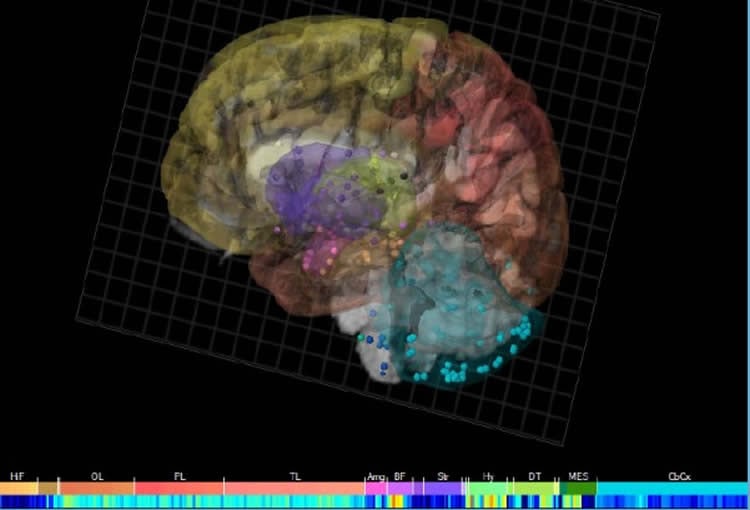Summary: A new study reports researchers have discovered an important mechanism that helps switch on a gene known to help protect against Alzheimer’s disease.
Source: MRC Clinical Sciences Center.
A team at the MRC Clinical Sciences Centre (CSC), based at Imperial College London, has found an important part of the machinery that switches on a gene known to protect against Alzheimer’s Disease.
Working in collaboration with scientists at the Hong Kong University (HKU) and the Erasmus University in Rotterdam, CSC associate professor Richard Festenstein explored the steps by which this Neuroglobin gene is gradually switched on, or up-regulated.
Neuroglobin has previously been shown to protect against Alzheimer’s disease in mice in which it makes the protective Neuroglobin. It is thought that the gene might play a protective role early in the disease in patients, but appears to be down-regulated as the disease progresses. It may therefore prove useful in developing new ways to try to prevent or treat this common cause of dementia, for which there is currently no cure.
Professor Festenstein and Dr Tan-Un from HKU, with help from Professor Sjaak Phillipsen at the Erasmus University, examined how the Neuroglobin gene ‘folds up’ in the cell using a technique called chromosome conformation capture. In results published today in the journal Nucleic Acids Research, they showed that a particular region of DNA, outside the coding region of the Neuroglobin gene itself, loops round to make contact with the start of the gene.
They tested the ability of this newly-identified DNA region to switch on the Neuroglobin gene using two approaches. First, they linked the DNA region directly to another so-called ‘reporter’ gene, and demonstrated simply that it does indeed act as an up-regulator. Second, they used the new ‘Crispr’ technique of gene editing to completely remove this section of DNA from the cell, and showed that the Neuroglobin gene was no longer switched on.

Together, the results gave the team confidence that this newly-identified DNA region is indeed a powerful switching mechanism of the Neuroglobin gene.
As Neuroglobin is thought to be protective in Alzheimer’s, it may be possible in the future to use this ‘switch’ in developing new treatments, such as gene therapy. Such therapeutic approaches require a compact ‘chunk’ of DNA to be most efficient. Importantly, the team pinpointed the position of the new regulatory region, and found that it is some distance away from the Neuroglobin gene itself. It may now be possible to remove the less relevant sections of DNA in between the Neuroglobin gene and its regulator to create an efficient therapeutic gene therapy unit. It may be that this target may prove useful not only in Alzheimer’s but also in other neurodegenerative diseases.
Source: Susan Watts – MRC Clinical Sciences Center
Image Source: NeuroscienceNews.com image is credited to The Allen Human Brain Atlas.
Original Research: Full open access research for “Identification of a novel distal regulatory element of the human Neuroglobin gene by the chromosome conformation capture approach” by Kin Tung Tam, Ping Kei Chan2, Wei Zhang, Pui Pik Law, Zhipeng Tian, Godfrey Chi Fung Chan, Sjaak Philipsen, Richard Festenstein and Kian Cheng Tan-Un in Nucleic Acids Research. Published online September 19 2016 doi:10.1093/nar/gkw820
[cbtabs][cbtab title=”MLA”]MRC Clinical Sciences Center. “Genetic Switch Identified as Potential Target For Alzheimer’s.” NeuroscienceNews. NeuroscienceNews, 20 September 2016.
<https://neurosciencenews.com/neuroglobin-genetics-alzheimers-5086/>.[/cbtab][cbtab title=”APA”]MRC Clinical Sciences Center. (2016, September 20). Genetic Switch Identified as Potential Target For Alzheimer’s. NeuroscienceNews. Retrieved September 20, 2016 from https://neurosciencenews.com/neuroglobin-genetics-alzheimers-5086/[/cbtab][cbtab title=”Chicago”]MRC Clinical Sciences Center. “Genetic Switch Identified as Potential Target For Alzheimer’s.” https://neurosciencenews.com/neuroglobin-genetics-alzheimers-5086/ (accessed September 20, 2016).[/cbtab][/cbtabs]
Abstract
Identification of a novel distal regulatory element of the human Neuroglobin gene by the chromosome conformation capture approach
Neuroglobin (NGB) is predominantly expressed in the brain and retina. Studies suggest that NGB exerts protective effects to neuronal cells and is implicated in reducing the severity of stroke and Alzheimer’s disease. However, little is known about the mechanisms which regulate the cell type-specific expression of the gene. In this study, we hypothesized that distal regulatory elements (DREs) are involved in optimal expression of the NGB gene. By chromosome conformation capture we identified two novel DREs located −70 kb upstream and +100 kb downstream from the NGB gene. ENCODE database showed the presence of DNaseI hypersensitive and transcription factors binding sites in these regions. Further analyses using luciferase reporters and chromatin immunoprecipitation suggested that the −70 kb region upstream of the NGB gene contained a neuronal-specific enhancer and GATA transcription factor binding sites. Knockdown of GATA-2 caused NGB expression to drop dramatically, indicating GATA-2 as an essential transcription factor for the activation of NGB expression. The crucial role of the DRE in NGB expression activation was further confirmed by the drop in NGB level after CRISPR-mediated deletion of the DRE. Taken together, we show that the NGB gene is regulated by a cell type-specific loop formed between its promoter and the novel DRE.
“Identification of a novel distal regulatory element of the human Neuroglobin gene by the chromosome conformation capture approach” by Kin Tung Tam, Ping Kei Chan2, Wei Zhang, Pui Pik Law, Zhipeng Tian, Godfrey Chi Fung Chan, Sjaak Philipsen, Richard Festenstein and Kian Cheng Tan-Un in Nucleic Acids Research. Published online September 19 2016 doi:10.1093/nar/gkw820






